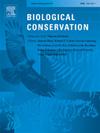农业景观中传粉昆虫的生物多样性以及天气和保护管理的作用
IF 4.9
1区 环境科学与生态学
Q1 BIODIVERSITY CONSERVATION
引用次数: 0
摘要
无数昆虫物种为我们的经济植物免费授粉,温带草原是本地传粉昆虫生存的重要生态系统。我们的研究是为了在天气变化的背景下比较受保护草原和农用草原的传粉昆虫生物多样性指数。我们重点研究了鳞翅目和鞘翅目昆虫的物种丰富度和丰度,以及蜜蜂(Apis mellifera mellifera)的种群密度。利用两个因素对保护区和农用草地进行了比较:(我们发现,影响最大的特征是花的丰度,其次是即时天气、保护管理和季节性天气。管理主要影响传粉昆虫的物种多样性。花卉丰度对各组昆虫都有影响。我们观察到近期天气的影响非常明显,尤其是温度和风力。值得注意的是,即时天气和花卉丰度的影响远远大于管理的影响。同样引人注目的是,季节性天气的影响较小。由此看来,即时天气和花卉丰度对传粉昆虫的影响很大。我们的结论是,天气对昆虫授粉昆虫有很大影响,但保护管理仍然是支持授粉昆虫的关键措施。好消息是,授粉昆虫可以在保护区外找到栖息地,这要归功于充足的植物花期。本文章由计算机程序翻译,如有差异,请以英文原文为准。
Biodiversity of pollinators in agricultural landscapes and the role of weather and conservation management
Myriads of insect species pollinate our economic plants for free and temperate grasslands are important ecosystems for the survival of native pollinators.
Our study was conducted to compare pollinator biodiversity indices between protected and agricultural grasslands in the context of changing weather.
We studied pollinators within the Polabí lowland (Czech Republic) in 2022. We focused on the species richness and abundance of Lepidoptera and Coleoptera and the population density of the Honey bee (Apis mellifera mellifera). Protected areas and agricultural grasslands were compared using two factors: (i) the influence of immediate weather at 126 sites and (ii) the influence of seasonal weather at 30 sites.
We found that the most influential characteristic was floral abundance, followed by immediate weather, conservation management and seasonal weather. Management primarily influenced pollinator species diversity. Floral abundance intensity affected insects across groups. We observed a very conclusive effect of immediate weather, especially temperature and wind. Seasonal weather only influenced butterfly species richness.
Notably, immediate weather and floral abundance were much more influential than the influence of management. Equally striking was the low influence of seasonal weather. It appears that the immediate weather and floral abundance strongly influenced pollinators. Therefore, weather can influence the accurate assessment of the impact of management in the landscapes.
We conclude that weather strongly influences insect pollinators, but conservation management remains a key measure for supporting pollinators. The good news is that pollinators can find habitat outside of protected areas thanks to complementation in the form of sufficient plant flowering time.
求助全文
通过发布文献求助,成功后即可免费获取论文全文。
去求助
来源期刊

Biological Conservation
环境科学-环境科学
CiteScore
10.20
自引率
3.40%
发文量
295
审稿时长
61 days
期刊介绍:
Biological Conservation is an international leading journal in the discipline of conservation biology. The journal publishes articles spanning a diverse range of fields that contribute to the biological, sociological, and economic dimensions of conservation and natural resource management. The primary aim of Biological Conservation is the publication of high-quality papers that advance the science and practice of conservation, or which demonstrate the application of conservation principles for natural resource management and policy. Therefore it will be of interest to a broad international readership.
 求助内容:
求助内容: 应助结果提醒方式:
应助结果提醒方式:


